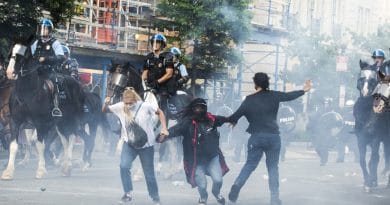2 Indigenous convoy protesters say they were victims of heavy-handed police response in Ottawa
Three weeks after RCMP tactical officers smashed their way into his motorhome during an operation to clear the convoy protest around Parliament Hill, Wayne Narvey drove his patched-up vehicle through a winding country back road tailed by three Ontario Provincial Police SUVs.
Earlier that evening, March 3, the OPP ended plans by Narvey and a handful of others to set up a protest camp on a patch of federal government land near a small rural airport to continue what they call the “freedom movement” after it was pushed out of downtown Ottawa. Navery, and some of the other protesters there, had been part of the Ottawa protest against pandemic-related mandates and restrictions since it began.
“We have an hour to leave,” Narvey was told by another demonstrator named Justin as OPP vehicles with flashing lights waited on the road.
Some of the windows in the motorhome were covered with black garbage bags and cold crept in through a door that couldn’t shut because of a broken latch. The group piled what they could — a wheelbarrow, propane tanks — into the back of a pickup truck and in Narvey’s motorhome and left, with the OPP keeping pace in the distance.
Narvey, 34, from Esgenoopetitj First Nation, a Mi’kmaq community in New Brunswick, was arrested by RCMP tactical officers at his motorhome on Feb. 18 and transferred to Ottawa police custody.
He was one of two Indigenous people involved in some of the most dramatic moments during the two-day police operation against the downtown Ottawa protest.
Women knocked down by police on horseback
The other, Candice Sero, 49, from Tyendinaga Mohawk territory, west of Napanee, Ont., is still recovering physically and emotionally after she was knocked to the ground by Toronto police officers on horseback on Feb. 19, according to her lawyer, Matthew Wolfson.
Sero declined to speak to CBC News despite repeated requests. The province’s Special Investigations Unit, which investigates injury or death that occurs during police activity, is probing the incident.
Wolfson said Sero, who uses a walker, was not provided any medical assistance by police on the scene, but was instead told to immediately leave the area. Wolfson said Sero managed to make her way to a nearby business and a patron there called an ambulance for her.
“It has left her shaken. This is one of the sweetest women in the world,” said Wolfson.
“Her heart is still there, but it’s had an effect on her mind and her energy.… She is trying to get through day by day, but the mental toll is something that is still fresh.”
Wolfson said he could not provide specific details of her injuries. He said she suffered injuries to the “upper right arm” area around her clavicle along with severe bruising.
According to her lawyer, Sero attended the protest because of the impact pandemic restrictions had on children.
WATCH | YouTube video captures moment Candice Sero was knocked over by a Toronto police horse:
https://www.youtube.com/watch?v=u2EvH_CKqy8
Wolfson said his office has been in touch with the SIU about her case. He said they are also considering filing a complaint with the Office of the Independent Police Review Director and helping her assess the possibility of filing a civil claim.
“After being hurt physically there was a complete lack of attention to her on the part of the police on her well-being and an absence of care,” said Wolfson, who is with David Anber’s Law Office, a firm based out of Ottawa.
The firm has provided legal services to those involved with the truck convoy protest.
Arrested again
Narvey, 34, who was released by Ottawa police the same day of his Feb. 18 arrest, said he joined the convoy to raise awareness of unmarked residential school graves and missing and murdered Indigenous women and girls. He wanted to continue his campaign and joined with the remnants of the trucker protest after they left downtown Ottawa.
First he joined a protest camp on a farm in Arnprior, Ont., about 50 kilometres west of Ottawa. Then he tried to set up a new camp on vacant federal land until the OPP arrived and ordered Narvey and a small number of protesters to leave.
When they did, the OPP tailed him and two other vehicles — including one driven by a CBC News reporter — about 100 kilometres west of Ottawa, deep into Renfrew County, heading to the private residence of Narvey’s friend, who offered him a place to park his motorhome for the night.

The OPP officers followed Narvey all the way to the edge of the private driveway. One officer said they were just there to make sure there were no issues. The three police SUVs then pulled away into the night.
In an emailed statement to CBC News, the OPP said it is keeping an eye on those involved in the Ottawa protests.
“The OPP is monitoring individuals who had been involved in the recent unlawful demonstrations in Ottawa to ensure there are no further breaches of the peace,” said the statement.
Despite this brush with police, Narvey said he was still committed to continuing the fight.
“As we regroup we will come back bigger and stronger,” said Narvey in an interview with CBC News after the OPP left.
But Narvey never got his chance to regroup. He was arrested by the OPP the next day after his friend drove him to the abandoned campsite to gather materials left behind the evening before in their rush to leave.
He was charged with two counts of mischief and two counts of obstructing a police officer and spent four nights in custody before he was released last Tuesday on a $3,000 bond.
Narvey, who has since returned home to New Brunswick, was already saddled with four charges — two counts of mischief, one count of obstruction of a police officer and one count of disobeying an order to leave under Ontario’s state of emergency — from his Feb. 18 arrest.
“We have a lot of trials in our lives. Those make us stronger in the end,” said Narvey before his March 3 arrest.
Narvey, a devout Christian, said he felt a calling to join the convoy protest. He said support from First Nation and non-First Nation communities poured in and he was able to gas up the motorhome and hit the road.
Missed daughter’s birthday
Narvey said his father was a trucker who died at the age of 42, so he knew once he arrived in Ottawa he “would be looked after.”
But it was tough being away from home, he said. He missed his nine-year-old daughter, Liberty’s, birthday on Feb. 5.
Narvey said he knows better than most involved in the Ottawa protests how the Canadian state can treat its citizens.
His grandparents attended Shubenacadie residential school and his community was at the centre of the Burnt Church crisis from 1999 to 2001 over the treaty right to fish lobster.
Narvey recalls watching from shore as Department of Fisheries and Oceans vessels rammed the smaller Mi’kmaq boats and tried to swamp them with their wake.
“Looking back, it doesn’t seem anything has changed. It seems we are still in that police state,” he said.
Narvey, who is unvaccinated, said that as a First Nations person, he’s always felt like a second-class citizen. With vaccine mandates, he said he felt like a fourth-class citizen.
“We are making history and we are making new beginnings,” he said.
WATCH | What happened when police tried to remove this convoy protester:
Wayne Narvey took part in the convoy protest in Ottawa and refused to leave his motorhome as police tried to remove him after the Emergencies Act gave them the ability to arrest protesters who refused to leave certain areas of the capital. He filmed what happened. 1:38
Narvey said his experience witnessing state violence against the fishermen and his faith in God allowed him to keep cool as he live streamed tactical officers smash his motorhome’s windows, pry open the door and toss in a canister with chemical irritant.
At one point, wearing a gas mask and shut inside the bathroom, he spoke into the camera.
“I am here for the murdered and missing Indigenous women, I am here for my daughter Liberty, I am here for her freedom,” said Narvey into his phone’s camera.
The live stream ended as tactical officers entered his motorhome. He told CBC News they broke down the bathroom door and an officer grabbed him by the neck and threw him down.
“My head hit off the stove, hit off the corner right there, the bench seat,” said Narvey, as he described what happened to CBC News.
The RCMP said in an emailed statement it does not comment on “specific information related to operations and tactics.” The statement said the RCMP operated under the “command” of the Ottawa police during protest enforcement in downtown Ottawa.
Narvey said he was diagnosed with a brain tumour five years ago that required him to undergo an emergency MRI if he ever suffered trauma to his head. He said Ottawa police took him to the Montfort Hospital for treatment but said he was denied a scan by the ER doctor who saw him.
The hospital said in a statement that it could not comment due to patient confidentiality.
Ottawa police also declined to comment.
Narvey is now home with his family. His next court dates for the two sets of charges are scheduled for March 17 and April 20.



